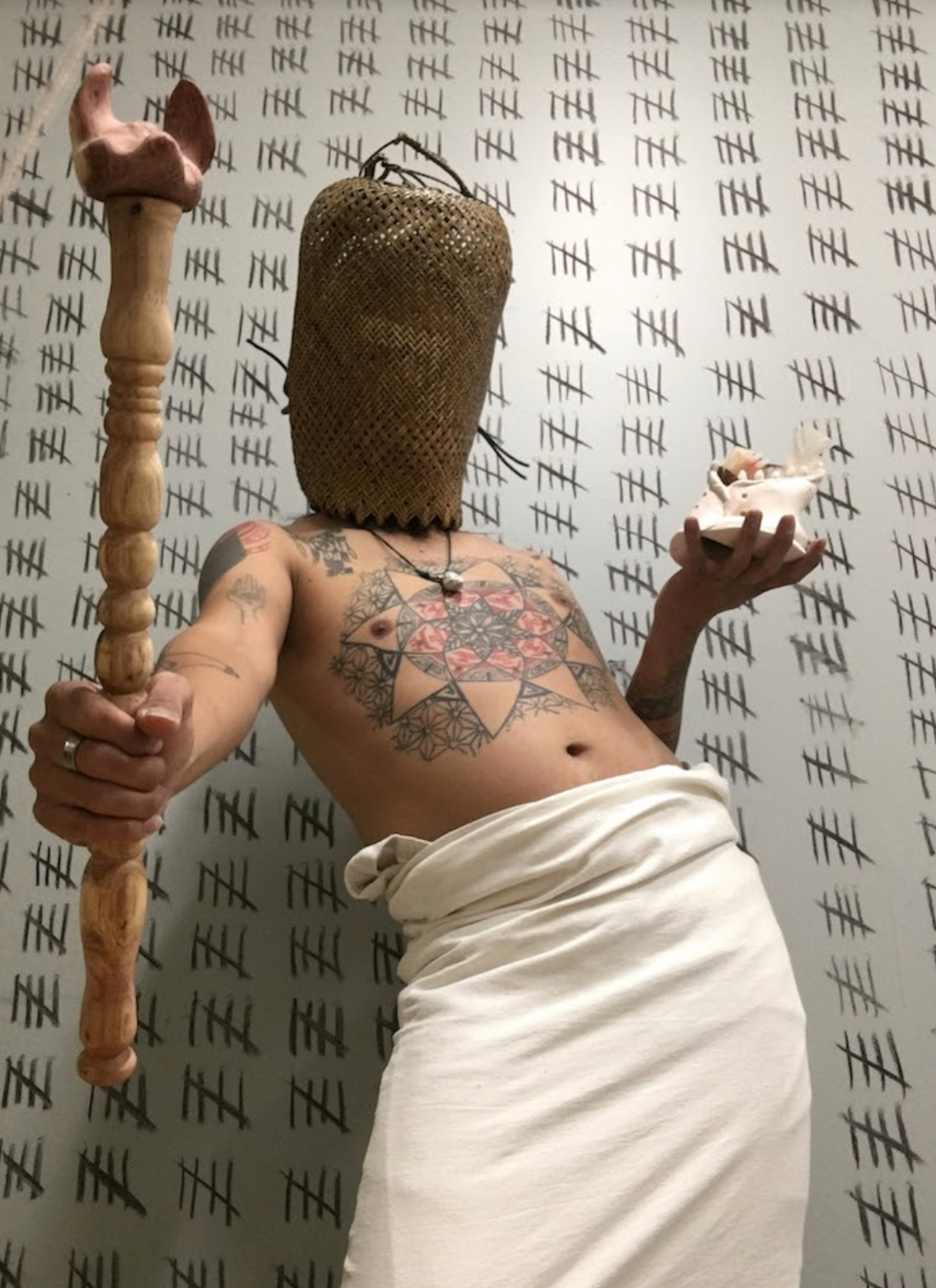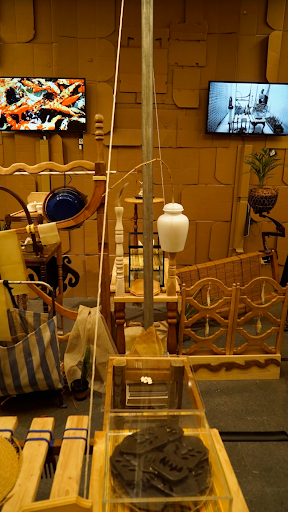{m} Artist interview:
Champoy.
written by Jennifer Co
We are continuing to hurtle towards our unknown futures, and it seems we’ve been made to console and brace ourselves for still more in the same breath. It is under all of this and a dusty blue 6:30 pm sky that {m}aganda Magazine and creator and teacher Champoy Lim made our way onto zoom for our first ever artist spotlight.
Back in July last year, we had the pleasure of speaking with the amazing artist named Champoy. Champoy was born in Bukidnon, Philippines and is now based in California, living as an interdisciplinary artist, educator, and performer. In our lovely chat with him, we discussed his early life being raised in Bukidnon, and the events that led to him being the spectacular artist that he is today. We also had the chance to talk about his work and how they manifested from his real life experiences, including his alternative habitat pieces that he collaborated on with various artists and communities. Check out our written piece about our discussion with Champoy, along with pictures of his work on our website: magandamagazine.org
CHAMPOY'S WEBSITE: www.champchampchampoy.com/about
CONTACT CHAMPOY AT: champchampchampoy@gmail.com
Interview done by Armel Ligeralde Zamora, Amira Nato, & Jennifer Co
Champoy, a current Berkeley MFA student, was born and raised in Bukidnon of Mindanao. He begins by acknowledging the Ohlone people whose land Berkeley’s institution is on, and welcomes us into conversation from the black and white lens of his video feed. There’s an unspoken acknowledgement of the circumstances we are in, of the world in which we are making space to connect with each other. But the complexity of the moment is one that he’s been tasked to hold from even a young age. Champoy talks about his upbringing in Camp Philips, a westernized plantation in the province of Bukidnon. “I just remember walking and running with our friends and neighbors or riding on our bikes and just trying to find when these fields would end... but it was just a vast ocean of pineapple,” he says, in recounting the vivid imagery of playing and wandering in the seemingly limitless expanse; named after Mark Phillips, an American war hero. He notes how much contrast it held to the rural area where his grandmother lived, and still more to the strict social interactions between neighborhood kids he sees as a parent in America, especially during quarantine. But Champoy honors the sensitivity that all this has instilled in him: “I’m fortunate in that sense, to be able to cross these worlds.”
It is a sensitivity that he also accredits to the political environment of his childhood, just before the EDSA revolution. “There was something in the air,” he says, while also acknowledging the suppression of knowledge to him as a kid. “That’s kind of a cultural thing… maybe generational or religious,” he says, describing the tension of growing up at that time: “you’re never fully engaged into the reality that you are aware of but can’t seem to contextualize, I guess.”
I think about all of us in our corners of the world, learning and unlearning what is becoming an increasingly bigger picture, and can’t help but feel that same tension. But Champoy does not shy away from the reclamation of this circumstance. “In my artwork I take out from a lot of these places, which is in some ways a kind of healing...But in a way I should be the one that’s responsible for that… knowing all of these things,” and from my side of the screen I am moved by the consolation of self alongside the call to uphold this experience for the next. Champoy remarks at the huge fraction of his upbringing that he was able to learn about only after enrolling into UC Berkeley, which poses an interesting question in our endeavours for bigger pictures: who has the knowledge, and why?

Champoy’s most recent work at the Worth Ryder Gallery: “That Which Pales In Contrast To… (Or What Is The Work And Who Is It For?). It is a full room installation whose site is right next to the Phoebe Hearst Museum of Anthropology, as Champoy nods to in leaving the door to it untouched. The museum houses many filipino artifacts, or as Champoy refers to as “Our Personal Objects”.
Champoy Lim, born Janeil Sumampong Lim, studied in the University of San Carlos, Cebu, as an advertising major; admittedly out of an evasion for mathematics. “Though the irony is that my dad was a math teacher before being an engineer,” he jokes. He describes the impulsive nature of his decision to come to the states: “there’s something about leaving the country that people really aspire to, and I want to say that I was never really attracted to that concept.” But he also acknowledges that he was not fully exempt from romanticising his move, “I was reading a lot of beat poetry at the time,” he laughs, “but this is a layer of colonization that I had to overcome,” be it in family or religion or the culture, “my choice of being here and just staying… I feel like that was more about me choosing this as a way to find a full expression of myself” that he knew he wouldn’t attain in the Philippines. “I felt that I already had a sense of who I would be if I stayed,” he says. “This is where I can do my work, the work I’m intended to do as an artist, as a person,” and he references the blood memory of our ancestors present in our own physical bodies, “I felt like my body could not move, when I suppose it was my time to go.”
In his time in LA before being admitted into Berkeley, he describes the deep sense of community he experienced in finding his footing in the US, calling it a “manifestation of the notion of kapwa, seeing yourself in the other,” and in a broader sense, the realization of what questions we must ask ourselves in forming community in this country: “how do we play out and position ourselves to counter, in a way, the empire of this colonial project that is the United States?”
Even in regards to the current discourse over filipinx versus filipino or filipina terminology, Champoy emphasizes the preservation of kapwa: “these are all just signifiers, in the end it’s just about finding each other.
But Champoy talks about this quality of community as something transcendent as much as it can be something to surmount as he transitioned from working textiles and office jobs into formally pursuing art. He references the feeling of indebtment, utang na loob, he had to counter in order to leave the opportunities that he knew had been gifted to him. “I just felt like I needed to do something more... How do you get up and keep working if you’re rotting inside?” and he recounts his vow to never work in an office again.
Champoy has since upheld that vow to himself, but the notions of kapwa and holding complexity has cemented itself into his current practice as both an artist and teacher. “Even until now, I still don’t see myself as an academic,” he admits, “am I just perpetuating this ‘art world’ that I’m also commenting about? It’s tricky… But I still think it’s an important space to occupy and be present in. The symbolic significance of being someone like me and taking up space and engaging with it,” especially in an institution like UC Berkeley.
“This work carried so much significance of what it means for me to be in this space, and addresses knowledge and language as colonial tools.” Champoy regards this installation as his way of speaking back to the space and reclaiming how he takes it. “I maybe went all out,” he admits, calling the installation a maximalist approach.
There is an urgency and significance to this moment that is specific to our time here alone. “The paradigm of how academia has been working... the white supremacist structures that have held it in place are shifting, and it’s important to really be there, and be part of the conversations being made,” he says. He goes on to talk about the critical feeling of being a fish out of water in these systems: “having that vulnerability, and really finding the strength within that knowing that you carry community with you. That kapwa, knowing I’m not just here for me.” As a teacher, Champoy lives this in his view of the classroom: “I’m always learning. The teaching hierarchies are so normalized, the teacher being the expert. But I try to be more of a facilitator.” He tells us that half the time it’s just a matter of being present, “meeting any student and engaging with them in a way that’s generative for them,” he continues, “it’s just learning how to be in relationship, and with anybody.”
In what inspires his art, he talks about assessing “what the dominant narratives are, and how do I counter them?” Something that he finds himself situated right in the middle of as a student at Berkeley. “Who holds all the knowledge, even the knowledge of our people. Who are the people between the knowledge and you? These institutions,” he answers, recalling a textbook on Camp Phillips and Bukidnon that only existed in UC Berkeley’s libraries. “I am crossing worlds where I’m never fully in both,” he says, but later continues, “I sit with the contradictions of this. Because there is a lot. This concept of being consistent. It’s a professionalism that I feel I’m always trying to be good at evading.”
Champoy plays with perception in this surrounding piece. “Parts of this installation address white supremacy, not directly, but I’m also just playing with concepts in this way because it depends on your position and where you’re looking at it from.” The piece includes details that require the viewer to bend and move within the space to see. “Depending on where you’re coming from you can see different levels of meaning being made,” he says.
Champoy’s works field many layers of heavy issues, self reckoning, culture; everything from the somber to the sarcastic. He knows that he’s holding his filipino background and decolonizing practices against an almost antithetical western upbringing and fine arts program. “This is something that I always try to acknowledge… it’s muddy,” he says, but also notes how this is the work that we are all tasked to do.
“How do we engage with a history that’s so complex? What parts of me are colonized or not?... but I don’t deny these parts. Just because I know it’s colonized does not mean that I can become someone else… because it’s layers of who we are that need to be acknowledged. The way I understand it, it’s to be able to empower ourselves, the continuity of our own indigeneity, that lineage. How do we acknowledge that and continue for this to thrive?”
And he reminds us that this empowerment is for all of us, “Everyone’s an artist,” he says, but also, “everyone should be more than an artist. The narrative of the genius artist toiling hard in his studio… those kinds of stories are so outdated.” In trying to find our own footing in the current of a living world, Champoy highlights the ongoing and collective process of it all: “it’s a dance. I miss my steps sometimes, but I’ll pick it up.. we’re always learning and dancing with others.”
The zoom is still for a moment and I remember sweetly my first semester in Maganda, curating the theme for {m}32’s Indak: to dance in time with the music, to move in rhythm to your community and the many layers of our diaspora, ourselves. We take a moment to celebrate Filipina textile artist Pacita Abad’s feature on the Google search page for the day. And Champoy bolsters her victory as evidence of this same kapwa, as being part of this same dance: “it’s also just collectivizing what the work is. It’s not just uplifting her but it’s uplifting all of us and the narratives that we have,” And Maganda looks forward to seeing Champoy’s own feature on the Google page.

Champoy was excited to get the back room of the exhibit for his installation. “Some people thought it was the storage room,” he jokes, but he felt it went hand in hand with what the installation was addressing: “I liked being in the back space because it felt like something to be discovered, and also what does it imply?”
background image is Pacita Abad’s “Wheels of Fortune” (2000)
Before the night ends, Maganda asks Champoy for his advice to the Berkeley filipino community, and to all of us as artists and dancers in this human experience. He references the term Kaalam in Bisaya, “this inner knowing, that you just know when you’re doing what you’re supposed to do.” Part of being able to get close to and identify that, he says, is to be grounded in your community. Even in the pursuit of art, which is almost intrinsically done for one’s personal satisfaction: “as contradictory as it might sound, there’s a level wherein you have to acknowledge who you’re in community with and who is holding you in your own pursuit and creative venture.” He asks Berkeley students to frame the right questions in what is otherwise nothing but a pursuit of attainment in this institution: what are we doing it for, and how do we locate ourselves in the structures we’re trying to transform?
And finally, he reminds us to be forgiving with ourselves, to keep on flowing, keep on making, and to be present. “If it brings you joy, it’s worth pursuing, and if you can share it then that’s even better.”
I switch on the lamp on my desk and look up to see that the dusty blue has been replaced with the last moon of the month. We wave our goodbyes from our respective places in the world, Champoy insisting we not hesitate to ask any other questions, “or even if you just want to make puppets,” he laughs. And we laugh. We take our places in the night, hurtling just as fast towards our future as before, but reminded that that future is collective, and of the company with which we dance, with which we pursue -- with which we are imagining the transformation that only we can. We thank Champoy for his time, insight, and wholehearted presence, and to our maganda community who reads this now, what an honor it is to be dancing with you <3
{m}aganda thanks Champoy for this moment
virtual click through of Champoy’s latest work “That Which Pales In Contrast To… (Or What Is The Work And Who Is It For?” at the Worth Ryder Gallery

Champoy challenges the idea of display as an art installation but also in the exhibits adjacence to the Phoebe Hearst Museum of Anthropology. “As people who’ve been put on display, and with a history like the St. Louis Fair.” He asks his audience members what it means to take up space, and to be in this space in particular? How do you navigate yourself here?

Champoy surrounds the room with cardboard boxes to connote the idea of being exported. “I was thinking about balikbayan boxes and being surrounded by water.”
![“It’s very dense and that’s the intention. You get so overwhelmed.” Champoy emphasizes an attention to detail that “you can’t see [certain things] without moving your body,” and talked a bit about this concept of “a lie that tells the truth” in work](https://images.squarespace-cdn.com/content/v1/5e55ccfef21f7571affa1eb7/1610699524840-TSIWHGMXM0X040B954F9/champoy+5.png)
“It’s very dense and that’s the intention. You get so overwhelmed.” Champoy emphasizes an attention to detail that “you can’t see [certain things] without moving your body,” and talked a bit about this concept of “a lie that tells the truth” in work that projects a truth though it may not be categorically true. He is looking towards prioritizing storytelling, performance, and collaboration as the future demands new mediums and circumstances for installations.

On the subject of anthropology as a white-centered science, Champoy emphasizes the importance of collaboration and community in addressing it: “maybe I’m being too contrarian but I also believe that we need to talk about brave safe spaces,” as much as we talk about safe spaces. “There are people trying to decolonize anthropology, the word itself has a very loaded connotation,” acknowledging that those endeavours are fielding very radical ideas, and we ought to collectivize our imagination for what the field could be if it were to be transformed. “I talk to people a lot which is apparently weird in Berkeley,” he jokes.

On the last two days of the installation Champoy activated the space by using the two screens on the side of the room for a karaoke party. A found kapwa.






